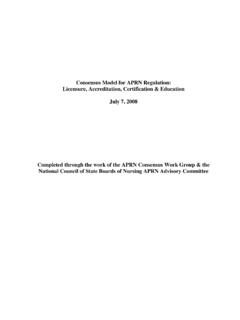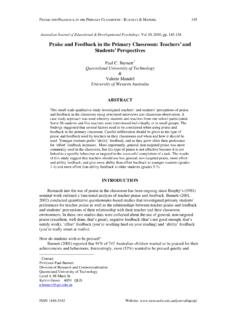Transcription of Vygotsky's Zone of Proximal Development: Instructional ...
1 English Language Teaching Vol. 3, No. 4; December 2010. Vygotsky's Zone of Proximal development : Instructional Implications and Teachers' Professional development Karim Shabani Faculty Member at Allameh Mohades Nouri University PhD Candidate of TEFL at University of Tehran, Iran E-mail: Mohamad Khatib Assistant Professor, Allameh Tabataba'i Uinversity (ATU), Tehran, Iran E-mail: Saman Ebadi PhD Candidate in TEFL, Allameh Tabatabie University, Tehran, Iran E-mail: Abstract The current paper examines the Instructional implications of Vygotsky's (1978) seminal notion of Zone of Proximal development , originally developed to account for the learning potential of children, and investigates ZPD. applications to the concept of teacher professional development . Specific attempt has been made to see how a number of assets at the teacher's disposal namely diary writing, peer and mentor collaboration, action research, practicum and TESOL discourse can serve as scaffolders to affect the progression of ZPD in language teachers.
2 The contributions of ZPD to the concepts of scaffolding and dynamic assessment (DA) are explored extensively and the controversial issues are addressed. There is a consensus that the notion of the zone of Proximal development and socio-cultural theory of mind based on Vygotsky's ideas are at the heart of the notion of scaffolding .This study highlights the limitations of the metaphor of scaffolding in interpreting the zone of Proximal development . The concept of ZPD, as seen through the approach of DA, offers an operational view of the learners' actual level of development and a measure of emerging and imminent development . Utilizing the concept of ZPD, DA unites traditional assessment, instruction, intervention, and remediation. Though the concept of ZPD provides an attractive metaphor for designing instruction and analyzing learning, it poses a real challenge when put into practice.
3 The present research highlights a procedure to provide a more tangible account of ZPD, but research on this area is scanty and further explorations and investigations are needed to reflect the implications of ZPD in Instructional context. Keywords: Zone of Proximal development (ZPD), Zone of actual development (ZAD), Intervention, Dynamic assessment (DA), Scaffolding, Intersubjectivity 1. Vygotsky on Learning and development Vygotsky is perhaps best known for his general genetic law of cultural development . We can formulate the general genetic law of cultural development as follows: every function in the cultural development of the child appears on the stage twice, first on the social plane and then, on the psychological plane first between people as an inter-mental category and then within the child as an intramental category. This pertains equally to voluntary attention, to logical memory, to the formation of concepts, and to the development of will.
4 (Vygotsky, 1997, p. 106). Kozulin (1990) indicates that Vygotsky's primary objective was to identify specifically human aspects of behavior and cognition' (p. 4) via genetic analysis methodology. He focused on several different domains of development : human evolution (phylogenesis), development of human cultures (sociocultural history), individual development (ontogenesis) and development which occurs during the course of a learning session or activity or very rapid change in one psychological function (microgenesis) (Wertsch, 1991). De Valenzuela (2006) asserts that while genetic analysis involves the examination of the origins and processes of development of higher mental processes within all of these domains, the most common foci of current educational research are ontogenesis and microgenesis. Wertsch and Tulviste (1992) interpreted Vygotsky's concept of the social origin of higher mental functioning as fundamentally distinct from how cognition has been traditionally viewed as a function of the individual.
5 They argued that Mind, cognition, memory, and so forth are understood not as attributes or properties of the individual, but as Published by Canadian Center of Science and Education 237. English Language Teaching Vol. 3, No. 4; December 2010. functions that may be carried out intermentally or intramentally' (p. 549). Vygotsky emphasized the importance of mediated activity' (1977, p. 71) in the development of higher psychological functions. He identified both physical tools and psychological tools as mediational means .However, for Vygotsky, psychological tools, particularly language, were of primary concern (John-Steiner & Mahn, 1996). De Valenzuela (2006) highlights the fact that a primary aspect of sociocultural theory is the positioning of social, rather than individual, processes as primary in the development of higher mental functions. Cole (1996) illustrated this focus on social processes and the importance of context in the following: Because what we call mind works through artifacts, it cannot be unconditionally bounded by the head or even by the body, but must be seen as distributed in the artifacts which are woven together and which weave together individual human actions in concert with and as a part of the permeable, changing, events of life.
6 (pp. 136 137). Sociocultural theory of mind attempts to account for the processes through which, learning and development take place. De Valenzuela (2006) rightly points out that cognitive development is seen not as unfolding in a biologically driven sequence, but as emerging as a result of interactions within a cultural and historical context. In this view, learning is seen as leading, or fostering, cognitive development . Vygotsky (1962) indicates that development cannot be separated from its social and cultural context, so the only way to explore mental processes is through understanding Vygotsky's concept of mediation that made a breakthrough in our understanding of learners' development . Vygotsky (1982) reiterates the fact that social interaction with cultural artifacts forms the most important part of learner's psychological development .Cultural tools or artifacts include all the things we use, from simple things such as a pen, spoon, or table, to the more complex things such as language, traditions, beliefs, arts, or science (Cole, 1997.)
7 Vygotsky, 1982). Vygotsky (1962) states in his genetic law of development that any higher mental function necessarily goes through an external social stage in its development before becoming an internal, truly mental function. Thus, the function is initially social and the process through which it becomes an internal function is known as internalization .The role of social mediation in internalization process has been strongly emphasized in socio cultural theory. Central to the concept of mediation is intersubjectivity which is described by Wertsch (1985, 1998) as the establishment of shared understandings between the learner and the tutor (Dixon-Krauss, 1996). Rommetveit (1974, 1985) refers to intersubjectivity as the establishment of a shared perspective between an expert and a learner in a problem-solving task. Verenikina (2003) asserts that intersubjectivity is considered as a key step in the process of internalization as the adult gradually removes the assistance and transfers responsibility to the child.
8 In the zone of Proximal development , we look at the way that a learner's performance is mediated socially, that is, how shared understanding or intersubjectivity has been achieved through moving the learners from current capabilities to a higher, culturally mediated level of development 2. Zone of Proximal development The concept of zone of Proximal development (ZPD) was developed by Lev Semenovich Vygotsky during the late 1920s and elaborated progressively until his death in 1934. In Mind in Society: The development of Higher Psychological Processes, Vygotsky defined the ZPD as the distance between the actual development level as determined by independent problem solving and the level of potential development as determined through problem solving under adult guidance or in collaboration with more capable peer (p. 86). That is, the ZPD was understood by Vygotsky to describe the current or actual level of development of the learner and the next level attainable through the use of mediating semiotic and environmental tools and capable adult or peer facilitation.
9 The idea is that individuals learn best when working together with others during joint collaboration, and it is through such collaborative endeavors with more skilled persons that learners learn and internalize new concepts, psychological tools, and skills. Roosevelt (2008) holds that the main goal of education from Vygotskian perspective is to keep learners in their own ZPDs as often as possible by giving them interesting and culturally meaningful learning and problem-solving tasks that are slightly more difficult than what they do alone, such that they will need to work together either with another, more competent peer or with a teacher or adult to finish the task. The idea is that after completing the task jointly, the learner will likely be able to complete the same task individually next time, and through that process, the learner's ZPD for that particular task will have been raised.
10 This process is then repeated at the higher level of task difficulty that the learner's new ZPD requires. This concept is illustrated in Figure 1. (Campbell ,2008, p. 3). The tasks assigned to the learners sometimes fall outside the ZPD that the learner can already do, or tasks that the learner would not be able to do even with help, for example trying to teach the average 10 year old to solve quadratic equations. Thus the focus of teaching is on tasks inside the ZPD which the learner cannot do by him or herself but has 238 ISSN 1916-4742 E-ISSN 1916-4750. English Language Teaching Vol. 3, No. 4; December 2010. the potential to accomplish with the guidance of others. As the learner accomplishes the task, his or her ZPD, or the gap between what he or she can do on their own and what he or she can only accomplish with assistance shrinks. This shrinking of the ZPD is illustrated in Figure 2.
















